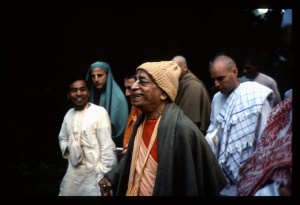CC Madhya 6.152 (1975): Difference between revisions
(Vanibot #0027: CCMirror - Mirror CC's 1996 edition to form a basis for 1975) |
(Vanibot #0020: VersionCompareLinker - added a link to the Version Compare feature) |
||
| Line 2: | Line 2: | ||
<div style="float:left">'''[[Sri Caitanya-caritamrta (1975)|Śrī Caitanya-caritāmṛta (1975)]] - [[CC Madhya (1975)|Madhya-līlā]] - [[CC Madhya 6 (1975)|Chapter 6: The Liberation of Sārvabhauma Bhaṭṭācārya]]'''</div> | <div style="float:left">'''[[Sri Caitanya-caritamrta (1975)|Śrī Caitanya-caritāmṛta (1975)]] - [[CC Madhya (1975)|Madhya-līlā]] - [[CC Madhya 6 (1975)|Chapter 6: The Liberation of Sārvabhauma Bhaṭṭācārya]]'''</div> | ||
<div style="float:right">[[File:Go-previous.png|link=CC Madhya 6.151 (1975)|Madhya-līlā 6.151]] '''[[CC Madhya 6.151 (1975)|Madhya-līlā 6.151]] - [[CC Madhya 6.153 (1975)|Madhya-līlā 6.153]]''' [[File:Go-next.png|link=CC Madhya 6.153 (1975)|Madhya-līlā 6.153]]</div> | <div style="float:right">[[File:Go-previous.png|link=CC Madhya 6.151 (1975)|Madhya-līlā 6.151]] '''[[CC Madhya 6.151 (1975)|Madhya-līlā 6.151]] - [[CC Madhya 6.153 (1975)|Madhya-līlā 6.153]]''' [[File:Go-next.png|link=CC Madhya 6.153 (1975)|Madhya-līlā 6.153]]</div> | ||
{{CompareVersions|CC|Madhya 6.152|CC 1975|CC 1996}} | |||
{{RandomImage}} | {{RandomImage}} | ||
==== TEXT 152 ==== | ==== TEXT 152 ==== | ||
| Line 11: | Line 10: | ||
<div class="verse"> | <div class="verse"> | ||
:ṣaḍ-aiśvarya-pūrṇānanda-vigraha yāṅhāra | :ṣaḍ-aiśvarya-pūrṇānanda-vigraha yāṅhāra | ||
:hena-bhagavāne tumi kaha nirākāra? | :hena-bhagavāne tumi kaha nirākāra ? | ||
</div> | </div> | ||
| Line 25: | Line 24: | ||
<div class="translation"> | <div class="translation"> | ||
"Are you describing as formless that Supreme Personality of Godhead whose transcendental form is complete with six transcendental opulences? | |||
</div> | </div> | ||
| Line 32: | Line 31: | ||
<div class="purport"> | <div class="purport"> | ||
If the Supreme Personality of Godhead is formless, how can He be said to walk very fast and accept everything offered to Him? Rejecting the direct meaning of the Vedic mantras, the Māyāvādī philosophers interpret them and try to establish the Absolute Truth as formless. Actually, the Supreme Lord has an eternal personal form full of all opulence. The Māyāvādī philosophers try to interpret the Absolute Truth as being without potency. However, in the Śvetāśvatara Upaniṣad (6.8) it is clearly said, parāsya śaktir vividhaiva śrūyate: | If the Supreme Personality of Godhead is formless, how can He be said to walk very fast and accept everything offered to Him? Rejecting the direct meaning of the Vedic mantras, the Māyāvādī philosophers interpret them and try to establish the Absolute Truth as formless. Actually, the Supreme Lord has an eternal personal form full of all opulence. The Māyāvādī philosophers try to interpret the Absolute Truth as being without potency. However, in the Śvetāśvatara Upaniṣad (6.8) it is clearly said, parāsya śaktir vividhaiva śrūyate: "The Absolute Truth has multipotencies." | ||
</div> | </div> | ||
Latest revision as of 18:35, 27 January 2020

A.C. Bhaktivedanta Swami Prabhupada
TEXT 152
- ṣaḍ-aiśvarya-pūrṇānanda-vigraha yāṅhāra
- hena-bhagavāne tumi kaha nirākāra ?
SYNONYMS
ṣaṭ-aiśvarya-pūrṇa—with six opulences in full; ānanda—blissful; vigraha—form; yāṅhāra—whose; hena-bhagavāne—unto that Supreme Personality of Godhead; tumi—you; kaha—said; nirākāra—without any form.
TRANSLATION
"Are you describing as formless that Supreme Personality of Godhead whose transcendental form is complete with six transcendental opulences?
PURPORT
If the Supreme Personality of Godhead is formless, how can He be said to walk very fast and accept everything offered to Him? Rejecting the direct meaning of the Vedic mantras, the Māyāvādī philosophers interpret them and try to establish the Absolute Truth as formless. Actually, the Supreme Lord has an eternal personal form full of all opulence. The Māyāvādī philosophers try to interpret the Absolute Truth as being without potency. However, in the Śvetāśvatara Upaniṣad (6.8) it is clearly said, parāsya śaktir vividhaiva śrūyate: "The Absolute Truth has multipotencies."